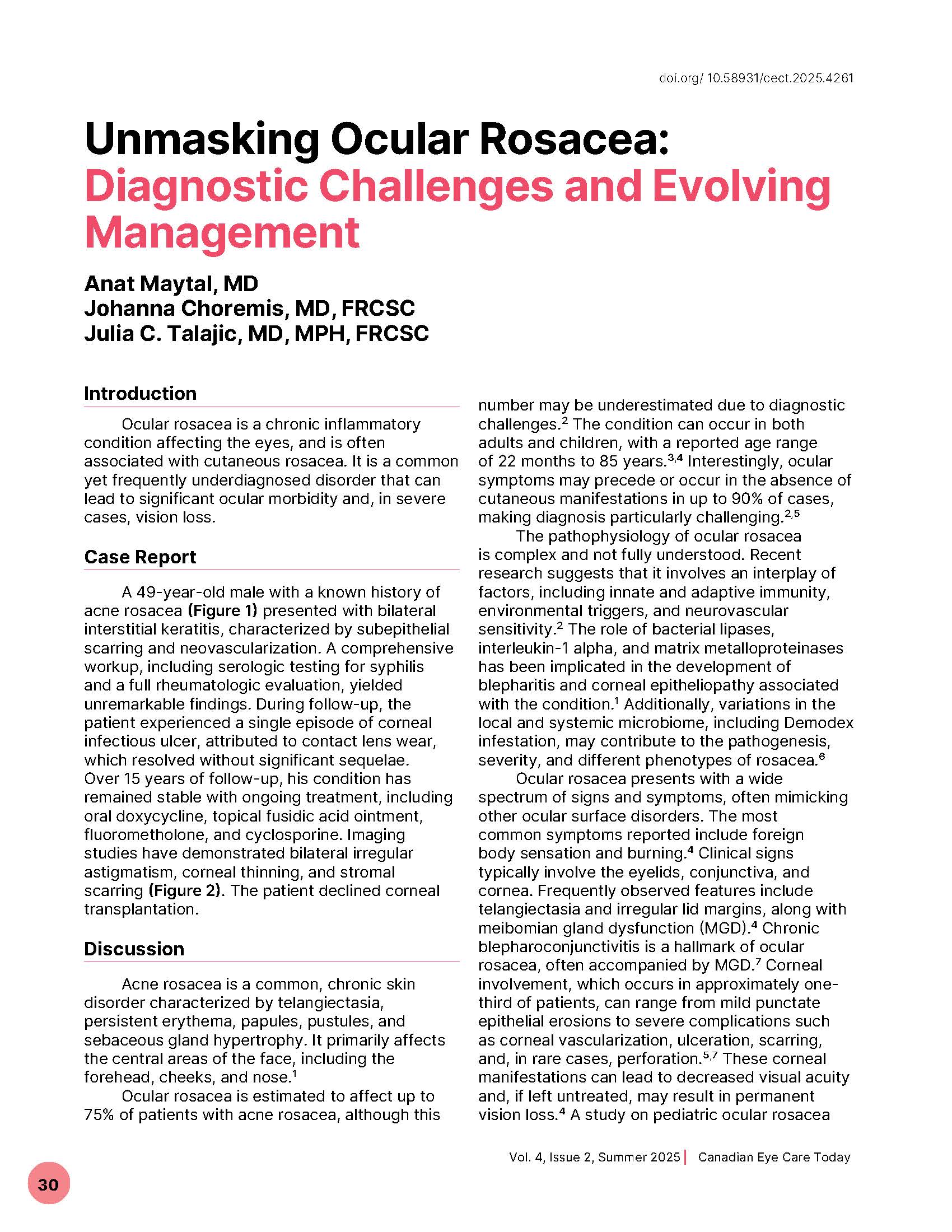Unmasking Ocular Rosacea: Diagnostic Challenges and Evolving Management
DOI:
https://doi.org/10.58931/cect.2025.4261Abstract
Ocular rosacea is a chronic inflammatory condition affecting the eyes, and is often associated with cutaneous rosacea. It is a common yet frequently underdiagnosed disorder that can lead to significant ocular morbidity and, in severe cases, vision loss.
References
Stone DU, Chodosh J. Oral tetracyclines for ocular rosacea: an evidence-based review of the literature. Cornea. 2004;23,106-109. doi:10.1097/00003226-200401000-00020 DOI: https://doi.org/10.1097/00003226-200401000-00020
Jabbehdari S, Caughlin B, Memar OM, Djalilian AR. Update on the pathogenesis and management of ocular rosacea: an interdisciplinary review. Eur J Ophthalmol. 2021;31,22-33. doi:10.1177/1120672120937252
Donaldson KE, Karp CL, Dunbar MT. Evaluation and treatment of children with ocular rosacea. Cornea. 2007;26,42-46. doi:10.1097/ICO.0b013e31802e3a54 DOI: https://doi.org/10.1097/ICO.0b013e31802e3a54
Akpek EK, Merchant A, Pinar V, Foster CS. Ocular rosacea: patient characteristics and follow-up. Ophthalmology. 1997;104:1863-1867. DOI: https://doi.org/10.1016/S0161-6420(97)30015-3
Vieira ACC, Höfling-Lima AL, Mannis MJ. Ocular rosacea: a review. Arquivos Brasileiros de Oftalmologia. 2012;75(5):363-369. doi:10.1590/s0004-27492012000500016 DOI: https://doi.org/10.1590/S0004-27492012000500016
Redd TK, Seitzman GD. Ocular rosacea. Curr Opin Ophthalmol. 2020;31(6):503–507. doi:10.1097/ICU.0000000000000706 DOI: https://doi.org/10.1097/ICU.0000000000000706
Tavassoli S, Wong N, Chan E. Ocular manifestations of rosacea: a clinical review. Clin Exp Ophthalmol. 2021;49(2):104-117. doi:10.1111/ceo.13900
Nazir SA, Murphy S, Siatkowski RM, Chodosh J, Siatkowski RL. Ocular rosacea in childhood. Am J Ophthalmol. 2004;137(1):138-144. doi:10.1016/s0002-9394(03)00890-0 DOI: https://doi.org/10.1016/S0002-9394(03)00890-0
Liang H, Randon M, Michee S, Tahiri R, Labbe A, Baudouin C. In vivo confocal microscopy evaluation of ocular and cutaneous alterations in patients with rosacea. Br J Ophthalmol. 2017;101(3):268-274. doi:10.1136/bjophthalmol-2015-308110 DOI: https://doi.org/10.1136/bjophthalmol-2015-308110
Gallo RL, Granstein RD, Kang S, Mannis M, Steinhoff M, Tan J, et al. Standard classification and pathophysiology of rosacea: the 2017 update by the National Rosacea Society Expert Committee. J Am Acad Dermatol. 2018;78(1):148-155. doi:10.1016/j.jaad.2017.08.037 DOI: https://doi.org/10.1016/j.jaad.2017.08.037
An HJ, Ninonuevo M, Aguilan J, Liu H, Lebrilla CB, Alvarenga LS, et al. Glycomics analyses of tear fluid for the diagnostic detection of ocular rosacea. J Proteome Res. 2005;4(6),1981-1987. doi:10.1021/pr0501620 DOI: https://doi.org/10.1021/pr0501620
Abokwidir M, Feldman SR. Rosacea management. Skin Appendage Disord. 2016;2(1-2):26-34. doi:10.1159/000446215 DOI: https://doi.org/10.1159/000446215
Tavassoli S, Wong N, Chan E. Ocular manifestations of rosacea: a clinical review. Clin Exp Ophthalmol. 2021;49:104-117. doi:10.1111/ceo.13900 DOI: https://doi.org/10.1111/ceo.13900
Geng RS, Slomovic J, Bourkas AN, Slomovic AR, Sibbald RG. Ocular rosacea: the often‐overlooked component of rosacea. JEADV Clinical Practice. 2024;3:1349-1363. doi: 10.1002/jvc2.428 DOI: https://doi.org/10.1002/jvc2.428
Wladis EJ, Adam AP. Current and emerging therapies for ocular rosacea. US Ophthalmic Review. 2013;6:86. doi: 10.17925/USOR.2013.06.02.86 DOI: https://doi.org/10.17925/USOR.2013.06.02.86
Jabbehdari S, Memar O, Caughlin B, Djalilian AR. Update on the pathogenesis and management of ocular rosacea: an interdisciplinary review. Eur J Ophthalmol. 2020;31(1):22-33. doi:10.1177/1120672120937252 DOI: https://doi.org/10.1177/1120672120937252
Pellegrini F, Vincigiuerra A, Maria A. Spontaneous bilateral corneal perforation in ocular rosacea. Eur J Ophthalmol. 2024;34(3):NP5-NP7. doi:10.1177/11206721231212087 DOI: https://doi.org/10.1177/11206721231212087
Korting HC, Schöllmann C. Tetracycline actions relevant to rosacea treatment. Skin Pharmacol Physiol. 2009;22(6):287-294. doi:10.1159/000235550 DOI: https://doi.org/10.1159/000235550
Sobolewska B, Doycheva D, Deuter C, Pfeffer I, Schaller M, Zierhut M. Treatment of ocular rosacea with once-daily low-dose doxycycline. Cornea. 2014;33(3):257-260. doi:10.1097/ICO.0000000000000051 DOI: https://doi.org/10.1097/ICO.0000000000000051
Syed YY. Lotilaner Ophthalmic solution 0.25%: first approval [published correction appears in Drugs. 2023;83(16):1543. doi: 10.1007/s40265-023-01965-7.]. Drugs. 2023;83(16):1537-1541. doi:10.1007/s40265-023-01947-9 DOI: https://doi.org/10.1007/s40265-023-01947-9
Talha M, Haris Ali M, Fatima E, Nadeem A, Ahmed A, Nashwan AJ. Efficacy and safety of Lotilaner ophthalmic solution (0.25%) for the treatment of demodex blepharitis: a GRADE assessed systematic review and meta-analysis of observational & experimental studies. Am J Ophthalmol. 2024;264:8-16. doi:10.1016/j.ajo.2024.03.019 DOI: https://doi.org/10.1016/j.ajo.2024.03.019
Gonzalez-Salinas R, Massaro-Corredor M, Quiroz-Mercado H, Ramos-Betancourt N, Ceballos JC, Baba SN, et al. Safety and efficacy of topical Lotilaner ophthalmic solution 0.25% for the treatment of demodex blepharitis: a pilot study. J Ophthalmol. 2021; 2021:3862684. doi:10.1155/2021/3862684 DOI: https://doi.org/10.1155/2021/3862684
Sadri E, Paauw JD, Simmons B, Meyer J, Yeu E, Berdy GJ, et al. Long-term outcomes of 6-week treatment of Lotilaner ophthalmic solution, 0.25%, for demodex blepharitis: a noninterventional extension study. Cornea. 2024;43(11):1368-1374. doi:10.1097/ICO.0000000000003484 DOI: https://doi.org/10.1097/ICO.0000000000003484
Wladis EJ. Intraductal meibomian gland probing in the management of ocular rosacea. Ophthalmic Plast Reconstr Surg. 2012;28(6),416-418. doi:10.1097/IOP.0b013e3182627ebc DOI: https://doi.org/10.1097/IOP.0b013e3182627ebc
Kim BY, Moon HR, Ryu HJ. Comparative efficacy of short-pulsed intense pulsed light and pulsed dye laser to treat rosacea. J Cosmet Laser Ther. 2019;21(5):291-296. doi:10.1080/14764172.2018.1528371 DOI: https://doi.org/10.1080/14764172.2018.1528371
Schroeter CA, Haaf-Von Below S, Neumann HAM. Effective treatment of rosacea using intense pulsed light systems. Dermatol Surg. 2006;31(10):1285-1289. doi:10.1111/j.1524-4725.2005.31204 DOI: https://doi.org/10.1111/j.1524-4725.2005.31204
Dell SJ. Intense pulsed light for evaporative dry eye disease. Clin Ophthalmol. 2017;11:1167–1173. doi:10.2147/OPTH.S139894 DOI: https://doi.org/10.2147/OPTH.S139894
Vora GK, Gupta PK. Intense pulsed light therapy for the treatment of evaporative dry eye disease. Curr Opin Ophthalmol. 2015;26(4):314-318. doi:10.1097/ICU.0000000000000166 DOI: https://doi.org/10.1097/ICU.0000000000000166
Neuhaus IM, Zane LT, Tope WD. Comparative efficacy of nonpurpuragenic pulsed dye laser and intense pulsed light for erythematotelangiectatic rosacea. Dermatol Surg. 2009;35(6):920-928. doi:10.1111/j.1524-4725.2009.01156.x DOI: https://doi.org/10.1111/j.1524-4725.2009.01156.x
Fishman HA, Shah AA, Periman LM. Real-Time Video Microscopy of In Vitro Demodex Death by Intense Pulsed Light. Photobiomodul Photomed Laser Surg. 2020;38(8):472-476. doi:10.1089/photob.2019.4737 DOI: https://doi.org/10.1089/photob.2019.4737
Son M, Kang D, Oh S, Choi J, Shim M, Park J, et al. Radiofrequency irradiation attenuates angiogenesis and inflammation in UVB-induced rosacea in mouse skin. Exp Derm. 2020;29(7):659-666. doi:10.1111/exd.14115 DOI: https://doi.org/10.1111/exd.14115
Vassileva S, Tanev I, Drenovska K. Rosacea: the eyes have it. Clin Dermatol. 2023;41(4):528-536. doi:10.1016/j.clindermatol.2023.08.009 DOI: https://doi.org/10.1016/j.clindermatol.2023.08.009

Downloads
Published
How to Cite
Issue
Section
License
Copyright (c) 2025 Canadian Eye Care Today

This work is licensed under a Creative Commons Attribution-NonCommercial-NoDerivatives 4.0 International License.
